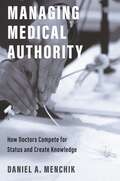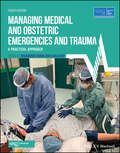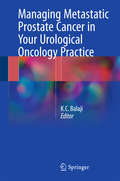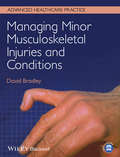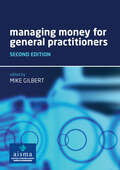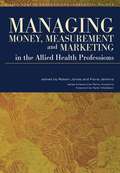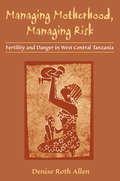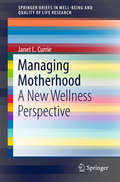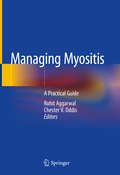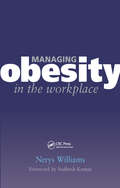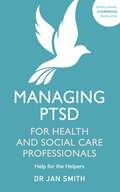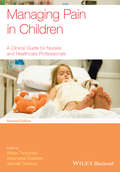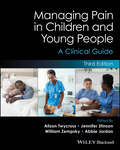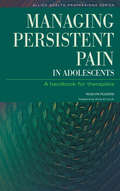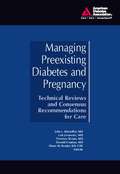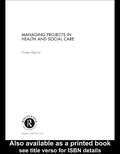- Table View
- List View
Managing Long-term Conditions and Chronic Illness in Primary Care: A Guide to Good Practice
by Judith CarrierThis practical guide will assist healthcare practitioners to manage and meet the physical and psycho-social needs of people with complex chronic diseases/long-term conditions. Systematic and evidence-based care which takes account of the expert patient and reduces unnecessary hospital admissions is vital to support those with long-term conditions/chronic diseases and those who care for them. Effective management of long-term conditions is an essential part of contemporary nursing and healthcare policy and practice globally. Reflecting recent changes in the curriculum, this fully updated multidisciplinary edition highlights the key issues in managing long-term conditions. It provides a practical and accessible guide for nurses and allied health professionals in the primary care environment including: case studies on HIV and dementia and content on mental health the physical and psychosocial impact of living with long-term conditions effective case management self-management and the expert patient behavioural change strategies and motivational counselling Packed with helpful, clearly written information, Managing Long-term Conditions and Chronic Illness in Primary Care includes case studies, fact boxes and pointers for practice. It is ideal reading for pre- and post-registration nursing students taking modules on long-term conditions and will be a valuable companion for pre-registration students on community placements.
Managing Madness: Weyburn Mental Hospital and the Transformation of Psychiatric Care in Canada
by Tracey Mitchell Erika Dyck Alexander Dyck John Mills Alex Deighton Hugh Lafave John Elias Gary GerberThe Saskatchewan Mental Hospital at Weyburn has played a significant role in the history of psychiatric services, mental health research, and providing care in the community. Its history provides a window to the changing nature of mental health services over the 20th century. Built in 1921, Saskatchewan Mental Hospital was considered the last asylum in North America and the largest facility of its kind in the British Commonwealth. A decade later the Canadian Committee for Mental Hygiene cited it as one of the worst facilities in the country, largely due to extreme overcrowding. In the 1950s the Saskatchewan Mental Hospital again attracted international attention for engaging in controversial therapeutic interventions, including treatments using LSD. In the 1960s, sweeping healthcare reforms took hold in the province and mental health institutions underwent dramatic changes as they began transferring patients into communities. As the patient and staff population shrunk, the once palatial building fell into disrepair, the asylum’s expansive farmland went out of cultivation, and mental health services folded into a complicated web of social and correctional services. Erika Dyck’s "Managing Madness" examines an institution that housed people we struggle to understand, help, or even try to change.
Managing Managed Care: Quality Improvement In Behavioral Health
by Committee on Quality Assurance Accreditation Guidelines for Managed Behavioral Health CareManaged care has produced dramatic changes in the treatment of mental health and substance abuse problems, known as behavioral health. Managing Managed Care offers an urgently needed assessment of managed care for behavioral health and a framework for purchasing, delivering, and ensuring the quality of behavioral health care. It presents the first objective analysis of the powerful multimillion-dollar accreditation industry and the key accrediting organizations.Managing Managed Care draws evidence-based conclusions about the effectiveness of behavioral health treatments and makes recommendations that address consumer protections, quality improvements, structure and financing, roles of public and private participants, inclusion of special populations, and ethical issues.The volume discusses trends in managed behavioral health care, highlighting the emerging role of the purchaser. The committee explores problems of overlap and fragmentation in the delivery of behavioral health care and discusses the issue of access, a special concern when private systems are restricted and public systems overburdened.Highly applicable to the larger health care system, this volume will be of particular interest to all stakeholders in behavioral health--federal and state policymakers, public and private purchasers, health care providers and administrators, consumers and consumer advocates, accrediting organizations, and health services researchers.
Managing Medical Authority: How Doctors Compete for Status and Create Knowledge
by Daniel A. MenchikHow the authority of medicine is continuously shaped by relationships among physicians, industry, colleagues, and organizations Exploring how the authority of medicine is controlled, negotiated, and organized, Managing Medical Authority asks: How is knowledge shared throughout the profession? Who makes decisions when your heart malfunctions—physicians, hospital administrators, or private companies who sell pacemakers? How do physicians gain and keep their influence? Arguing that medicine’s authority is managed in collegial competition across venues, Daniel Menchik examines the full range of stakeholders driving the direction of the field: medical trainees, clinicians, researchers, administrators, and even the corporations that develop groundbreaking technologies enabling longer and better lives.Menchik takes us into Superior Hospital to witness surgeries and executive negotiations. He moves outside the hospital to watch professional committees craft standards for treatments, case management, and professional ethics. At industry-sponsored meetings, he observes company representatives who train some experienced doctors on their technologies, while deterring others who they think might injure patients. Using an innovative ethnographic approach tying individual actions and their collective consequences, he considers how stakeholders ally across the various venues of medicine, even as they are sometimes pressed into competition within those venues. Menchik finds that these alliances and rivalries strengthen the authority of medicine as a whole. From place to place, and group to group, we see how a medical specialty renews and reinvigorates itself.Beginning within the walls of the hospital, and moving to the professional and commercial venues that shape it, Managing Medical Authority offers an agenda-setting take on the social organization of medical authority.
Managing Medical and Obstetric Emergencies and Trauma: A Practical Approach (Advanced Life Support Group)
by Advanced Life Support Group (ALSG)MANAGING MEDICAL AND OBSTETRIC EMERGENCIES AND TRAUMA: A PRACTICAL APPROACH Managing Medical and Obstetric Emergencies and Trauma provides an evidence-based, structured approach to the recognition and treatment of emergencies in pregnancy. This contemporary resource provides step-by-step guidance on the knowledge, practical skills and procedures required to improve outcomes for the mother and fetus. Now in its fourth edition, the text fully aligns with the mMOET course, and has been extensively reviewed and revised throughout. Lessons learned from mortality reports and national guidelines underpin the new material. This edition includes: New chapters on cardiac disease, neurological emergencies and human factors An update for obstetric teams treating pregnant trauma patients in line with modern trauma management Revised algorithms and new illustrations Managing Medical and Obstetric Emergencies and Trauma is a vital source of practical information presented as a systematic approach to prepare the obstetric team: obstetricians, midwives, anaesthetists and emergency physicians. The Advanced Life Support Group (ALSG) improves outcomes for people in life-threatening situations, anywhere along the healthcare pathway, anywhere in the world. ALSG is a leading medical education charity and has delivered advanced life support training to over 225000 clinicians in 44 countries, across 5 continents, for over 25 years. For more information on the complete rangeof Wiley medical student and junior doctorpublishing, please visit:www.wiley.comwww.com For more information on the Advanced LifeSupport Group, please visit: www.alsg.org To receive automatic updates on Wiley booksand journals, join our email list. Sign up todayat www.wiley.com/emailwww.email This new edition is also available as an e-book. For more details, please seewww.wiley.com/buy/9781119348382www.9781119348382 TITLES OF RELATED INTERESTTITLES INTEREST Pre-Obstetric Emergency Training: A Practical Approach2nd EditionAdvanced Life Support Group9781119348382August 2018 Pre-Hospital Paediatric Life Support: A Practical Approach to Emergencies3rd EditionAdvanced Life Support Group 9781118339763October 2017
Managing Metastatic Prostate Cancer In Your Urological Oncology Practice
by K. C. BalajiThis text provides a comprehensive review of pathophysiology, molecular and cell biology aspects of CRPC, discusses all major clinical trials that have led to approval of 6 new drugs since 2004, explores the role of bone preservation strategies, in depth analysis of combination and sequencing strategies, outlines upcoming novel drugs and trends in research, and stresses the role of palliative care in this incurable disease. Managing Metastatic Prostate Cancer in Your Urological Oncology Practice will serve as a very useful resource for physicians and researchers dealing with, and interested in prostate cancer. It provides a concise yet comprehensive summary of the current status of the field that will help guide patient management and stimulate investigative efforts. All chapters are written by experts in their fields and will include the most up to date scientific and clinical information.
Managing Minor Musculoskeletal Injuries and Conditions
by David BradleyEmergency care professionals are increasingly expected to work autonomously when caring for patients with minor musculoskeletal injuries and conditions. They have to be able to competently and safely take a patient's history, examine, diagnose and provide management of these conditions. Managing Minor Musculoskeletal Injuries and Conditions pulls together all these aspects of care into one practical, easy-to-read text.Aimed principally at students undertaking minor injury and emergency care courses, this title is a comprehensive manual of minor musculoskeletal injuries and conditions, highly illustrated throughout and containing a variety of activities and exercises.Key features:Includes material on study skills, distance and self-directed learning to support both students on formal courses and those working aloneExtensive learning features, including a range of activities, hints and tips and multiple-choice questionsSupported by a companion website with further self-assessment, downloadable X-ray PowerPoint slides, picture tutorials, practice history-taking documentation and legal scenariosEnables more effective management and care of patients with musculoskeletal injuries
Managing Money for General Practitioners, Second Edition
by Mike GilbertNow thoroughly revised and updated, the new edition of this popular book ensures that GPs and practice managers alike have a practical guide to the financial issues affecting medical practice. Although GPs delegate many of their management and administration functions to practice managers and other highly qualified staff, it is crucial for them to remain aware of how they are paid, how their income is taxed, how their tax will be settled, and the numerous financial problems that can arise in partnerships. Sound financial management is vital if these pitfalls are to be avoided. Written by specialists in the increasingly complex area of practice finance, this is an accessible guide for non-specialists, providing answers to routine queries and illustrating typical situations with worked examples.
Managing Money, Measurement and Marketing in the Allied Health Professions (Allied Health Professions - Essential Guides)
by Robert Jones Fiona JenkinsHigh-quality Allied Health delivery through a motivated, committed and expert workforce depends on strong management and leadership. To provide this, Allied Health Profession managers need solid, evidence-based business skills just as much as clinical knowledge and ability. This book focuses on the key management areas of money, measurement and marketing as applied to the Allied Health Professions. Bringing together nationally and internationally acknowledged and recognised experts from around the world, it explains the finances of healthcare, particularly in a cash-strapped environment, information and information management, and the marketing of services - in the broadest sense - based on a robust foundation of business planning and business-case development, project management, service level agreements and specification. Report writing and presentation skills are also covered, along with editors' quality and leadership evaluation framework, the Management Quality Matrix. The information, background and practical techniques covered in this book will make it a thought-provoking and indespensible resource both for managers and leaders of Allied Health Professionals and for those training future managers and leaders.
Managing Motherhood, Managing Risk: Fertility and Danger in West Central Tanzania
by Denise Roth AllenAn investigation of the consequences resulting from fertility-related development interventions in Tanzania
Managing Motherhood: A New Wellness Perspective (SpringerBriefs in Well-Being and Quality of Life Research)
by Janet L. CurrieThis book asserts that women attain higher levels of health in the mothering role when they achieve increased control over their own health, lifestyle and environment. Reflecting the philosophy of health promotion, it explores the meaning of the positive coping experience for new mothers, identifying the essential features of resilience in a new coping model based on ground-breaking analytical techniques. Further, the book discusses preventative strategies for building resilience and quality of life during the period of new motherhood, opening new horizons and dialogues related to what “coping” can actually mean when underpinned by a well-being paradigm.
Managing Myeloproliferative Neoplasms
by Mesa, Ruben A. and Harrison, Claire N. Ruben A. Mesa Claire N. HarrisonThis is a concise, practical, case-based book documenting examples and scenarios that will help you manage challenging clinical issues for patients with myeloproliferative neoplasms. The editors and authors have strived to distil the very latest information in this rapidly advancing field in a way that will help you to update your practice and manage your patients. The key focuses are: diagnosis, both standard and challenging; both day-to-day management as well as special situations such as surgery, thrombotic events and pregnancy; and finally, managing evolving situations with MPN such as progression to acute myeloid leukemia. This book is an outstanding resource that includes a discussion of both classical myeloproliferative neoplasms, such as essential thrombocythemia, polycythemia vera and myelofibrosis, and also less common disorders such as systemic mast cell disease, hypereosinophilia, MPN/MBS overlap syndromes and atypical CML, amongst others. This book is a practical reference for practitioners, hematologists, medical oncologists and trainees.
Managing Myositis: A Practical Guide
by Rohit Aggarwal Chester V. OddisThis comprehensive book serves as a guide in the day-to-day management of patients with idiopathic inflammatory myopathies (IIM), with a particular emphasis on adult dermatomyositis (DM), polymyositis (PM), juvenile dermatomyositis, necrotizing myositis, and inclusion body myositis. Practical in nature, it presents IIM concepts in a straightforward fashion, with high-quality figures, algorithms, and flowcharts supplementing each of the expertly authored chapters. The book begins with an introduction to myositis, providing an overview of the myositis basics and what type of patient is affected. Subsequent chapters are organized by the sequence in which a physician often manages myositis, from initial presentation and workup, to diagnosis, treatment, and finally prognostic and long-term outcome factors. The key differentials in various diagnostic studies are thoroughly examined, including electromyography, muscle biopsy, and MRI. Managing Myositis: A Practical Guide is an easy to-read, indispensable resource for internists, rheumatologists, dermatologists, pulmonologists, and neurologists.
Managing Obesity in the Workplace: Turning Tyrants into Tools in Health Practice, Book 3
by Nerys Williams Griselda Cooper"Managing Obesity in the Workplace" comprehensively examines how obesity impacts business and provides examples of action that can be taken by employers to prevent weight gain and facilitate weight loss in their staff. A considered, evidence-based analysis of the extent of the obesity problem reveals how this public health epidemic affects all workplaces influencing fitness to work, sickness absence, discrimination and bullying.Case studies from around the world clearly illustrate the extent of the problem and offer practical, innovative and budget friendly solutions for all businesses, large and small. With a focus on nutrition, physical activity, motivation and education, this book is ideal for occupational health professionals, public health and primary care doctors and nurses, health and safety officers, and nutritionists and dieticians. Organisations promoting workplace health, including sports/exercise equipment suppliers, will find it enlightening reading, as will business owners and managers.
Managing Obstetric Emergencies and Trauma
by Sara Paterson-Brown Charlotte Howell Paterson-Brown, Sara and Howell, CharlotteObstetric emergencies are unplanned and often unanticipated. Management requires a clear understanding of the life-saving and damage-limiting treatments that can be implemented. This manual covers life-threatening emergencies of pregnancy in a systematic and comprehensive way, teaching the skills and procedures needed to save the mother and fetus. Essential anatomical, physiological and pathological information is presented and clinically applied, and treatment algorithms give clear, step-by-step management advice. This easy to read, practical handbook is recommended reading prior to the Managing Obstetric Emergencies and Trauma (MOET) course, providing structured preparation and revision. It is also an aide mémoire for senior doctors facing rare events and is invaluable in promoting a multidisciplinary approach in complex conditions. Trainee obstetricians, midwives and anaesthetists will find this invaluable in developing their ability and confidence when facing emergencies, and a useful resource for advanced exams. No obstetric clinician should be without it!
Managing PTSD for Health and Social Care Professionals: Help for the Helpers
by Dr Jan SmithSince early 2020, the already considerable stresses of working in health or social care have been greater than at any point in recent history. If you work in one of these fields, you may well be experiencing symptoms of trauma, burnout or compassion fatigue and wondering how you might move forward when you are balanced on the edge. This book is a 2-part guide to managing the symptoms of post-traumatic stress disorder (PTSD) if you are a health or social care professional. It takes a practical but holistic approach, with the intention of helping you develop a sense of self-awareness, a clear idea of your values and - critically - a strong support network.You will learn effective techniques for self-care, through practices like mindfulness and meditation; you will also come to understand more about the symptoms of trauma, moral injury and burnout - with insights on practising defensively and clear guidance for what the different treatments for PTSD are, and how to seek professional help. Small enough to keep to hand in a locker or desk drawer, and designed to be read in short pauses in breaks or at the end of a long shift, without being complicated or taxing, this accessible introduction throws a life raft to any medical or social care professional overwhelmed by a challenging and stressful working environment.
Managing PTSD for Health and Social Care Professionals: Help for the Helpers
by Dr Jan SmithSince early 2020, the already considerable stresses of working in health or social care have been greater than at any point in recent history. If you work in one of these fields, you may well be experiencing symptoms of trauma, burnout or compassion fatigue and wondering how you might move forward when you are balanced on the edge. This book is a 2-part guide to managing the symptoms of post-traumatic stress disorder (PTSD) if you are a health or social care professional. It takes a practical but holistic approach, with the intention of helping you develop a sense of self-awareness, a clear idea of your values and - critically - a strong support network.You will learn effective techniques for self-care, through practices like mindfulness and meditation; you will also come to understand more about the symptoms of trauma, moral injury and burnout - with insights on practising defensively and clear guidance for what the different treatments for PTSD are, and how to seek professional help. Small enough to keep to hand in a locker or desk drawer, and designed to be read in short pauses in breaks or at the end of a long shift, without being complicated or taxing, this accessible introduction throws a life raft to any medical or social care professional overwhelmed by a challenging and stressful working environment.
Managing Pain in Children
by Alison Twycross Jennifer Stinson Stephanie DowdenProviding an evidence-based, practical guide to care in all areas of children's pain management, Managing Pain in Children offers nurses and other healthcare professionals an introduction to the skills and expertise to manage children's pain effectively.This fully-updated second edition first explores the relevant anatomy and physiology of children, the latest policy guidelines surrounding pain management and ethical issues involved in managing children's pain. Various pain assessment tools available for children and non-drug methods of pain relief are then explored and applied to practice in relation to acute pain, chronic pain, palliative care and the management of procedural pain.The evidence base, assessment techniques, pain-relieving interventions, and guidance for best practice in both hospital and community settings are covered throughout, making this title an ideal resource for all nurses and healthcare professionals working with children.
Managing Pain in Children and Young People: A Clinical Guide
by Alison Twycross Jennifer Stinson William T. Zempsky Abbie JordanMaster paediatric pain management with precision This practical guide equips nurses and healthcare professionals with evidence-based skills to effectively manage children's pain. Explore assessment techniques, pain relief strategies, and best practices for both hospital and community settings, with a focus on core knowledge, advanced insights, clinical scenarios, and practical tips. The fully updated third edition includes an expanded procedural sedation section, enhanced coverage of capnography for respiratory monitoring, a new quality improvement sciences section, and additional online MCQs and self-assessment material. Written by experienced authors, with contributions from global experts, Managing Pain in Children and Young People covers: Why pain prevention and treatment are crucial Pain's biopsychosocial nature and pharmacology of analgesic drugs Acute nociceptive, neuropathic, and visceral pain management Chronic headaches, post-surgical pain, neonatal pain, and procedural pain Paediatric palliative care and pain management in low-income countries Drug-free pain relief methods and ethical considerations With a multidisciplinary focus, this essential resource is tailored for healthcare practitioners working with children and young people; including doctors, nurses, psychologists, and physiotherapists. This essential resource empowers you to provide the best possible care for young patients, helping them find comfort and relief in their journey towards healing.
Managing Pediatric Obesity Using Advanced Therapies: Practical Guide for Pediatric Health Care Providers
by Claudia K. FoxTreatment of pediatric obesity, to date, has largely focused on lifestyle therapy. While lifestyle therapy is essential for obesity management, it is often insufficient, particularly for youth who have severe forms of the disease. Underlying the limitations of lifestyle therapy is the recognition that obesity is a biological disorder of the energy regulatory system and accordingly, to effectively manage obesity, the underpinning pathophysiology needs to be addressed. This pathophysiology can be targeted with more advanced therapies including anti-obesity medications and metabolic and bariatric surgery, two treatment strategies supported by the American Academy of Pediatrics. Written by leading experts in the field, A Practical Guide to Managing Pediatric Obesity is comprised of thirteen chapters, each including suggested protocols and case examples. The first chapter details the complex pathophysiology of obesity and sets the stage for why advanced therapies are critical for effective obesity management. Chapter two provides guidance on best practices for communicating with patients and families about obesity. The next three chapters provide direction on how to do a comprehensive patient assessment, and employ dietary and physical activity interventions. The heart of this guidebook is the chapter on pharmacological treatments, which details the mechanisms of action, research results, and recommendations for anti-obesity medication selection and monitoring outlined in a step-by-step fashion. Pre- and post-operative care for the pediatric bariatric surgery patient is detailed in the next chapter. Assessment and management of behavioral and psychological complications, type 2 diabetes, non-alcoholic fatty liver disease, polycystic ovary syndrome, hypertension, and dyslipidemia are covered in the subsequent five chapters. Syndromic and monogenic obesity are discussed in the final chapter.
Managing Persistent Organic Pollutants in India: Case Studies on Vapi and Surat, Gujarat (Emerging Contaminants and Associated Treatment Technologies)
by Paromita Chakraborty Luca Nizzetto Girija Bharat Eirik Steindal Satish SinhaPersistent Organic Pollutants (POPs) are a class of chemicals that are persistent, bio accumulative and toxic (PBT), which are restricted for use under the Stockholm Convention. They adversely impact the environment, human and animal health. Most of the POPs are semi-volatile organic compounds (SVOCs) and known to have a long-range transport potential and are often deposited in colder climate and found in places away from the regions they are produced. POPs are usually hydrophobic (i.e., “water-hating”) and lipophilic (i.e., “fat-loving”) chemicals, due to which they bind to solids, particularly organic matter, and fatty tissues in both marine and terrestrial environments. As a result, POPs may move up the food chain. This book focuses on determining the sources, fate, analytical techniques of detecting POPs as well as their health impacts. It further dwells on the regulatory aspects, management of POPs, best environmental practices (BEPs), Indian and international case studies, gaps in understanding the regulatory aspects. A few key recommendations for the way forward form the concluding chapters of this book.
Managing Persistent Pain in Adolescents: A Handbook for Therapists
by Ian Banks Roslyn RogersThis no-nonsense guide promotes a multidisciplinary approach to pain management in adolescent patients, acknowledging persistent pain is a complex biopsychosocial problem. With a strong focus on highly practical, applied strategies incorporating beliefs and values, mediation, relaxation, imagery, physical fitness and pacing, the book examines the many issues surrounding persistent pain. The thoughtful, compassionate approach considers lifestyle, family considerations and self-management in this unique population. Medical and psychological issues are highlighted throughout, with extensive use of case studies to illustrate important topics and potential obstacles. For Allied Health Professionals working with adolescent patients, this is the ideal practical guide.
Managing Post Polio: A Guide to Living Well with Post-Polio Syndrome
by Lauro S. Halstead Naomi NaiermanA book for those suffering from Post Polio Syndrome in all environments including social and vocational. The history of Polio and references for local Polio groups in the United States are included.
Managing Preexisting Diabetes and Pregnancy
by Lois Jovanovic Diane M. Reader Florence Brown Donald Coustan John L. KitzmillerManaging Preexisting Diabetes and Pregnancy is the American Diabetes Association's comprehensive guideline for this complex subject. It is an in-depth exploration of problems linked to pregnancy in diabetic women, as well as the heightened importance of blood glucose management during pregnancy. With contributions from some of the top professionals in the fields of diabetes and obstetric research, this guide is comprised of four sections that focus on managing diabetes before, during, and after pregnancy, as well as any potential complications. Loaded with the latest information regarding diabetes and pregnancy, Managing Preexisting Diabetes and Pregnancy serves as the essential guideline for the interested researcher, physician, or clinician.
Managing Projects in Health and Social Care
by Vivien MartinManaging Projects in Health and Social Care is designed for anyone who is asked to manage a public services project but who lacks the experience or training to feel confident in this role. The book shows how to use project management techniques to ensure that your project will be successful. The key dimensions discussed are: * budget* time* feasibility* planning / scheduling* implementation* evaluation.The book includes many examples to show how people have used the techniques described in health and care settings. There are clear explanations of how and when to use each technique and consideration of the differences between large and complex projects and smaller, less complicated ones. It is a valuable resource for anyone who wants to be sure that their project will make a useful contribution to improvement of health and care services.



